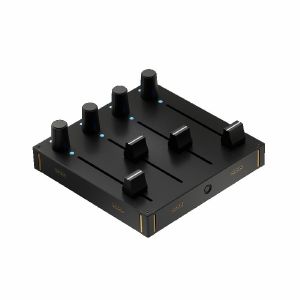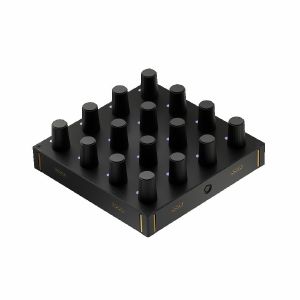Receive new release alerts for Intech Studio
Filter
Equipment
Format
Featured
Price
Tags
Artikel 1 bis 2 von 2 auf Seite 1 von 1 anzeigen
Intech Studio Grid EF44 4-Encoder & 4-Fader Modular MIDI Controller (modular MIDI controller)
Cat: 1032106 Rel: 28 Jan 25
Modular MIDI controller consisting of 4x encoders & 4x faders
Notes: Shape your sound with the EF44 Grid through fine-grained control over performance effects, modulation, panning and much more.
Geared with metal-shaft audio-grade linear faders and detent push-encoders. Seamless use for MIDI CC mapping for your DAW.
Equipped with customisable multi-coloured LED lights to enable labelling in dark environments. Facilitate differentiating each potmeter by changing the colour of each indicator LED, adjusting brightness levels individually or adding pulsing animations. All configurable in the Grid Editor. Each module is flexibly extendable with other Grid controllers enabled by the golden pins and magnets on all sides.
Thanks to its compact and lightweight structure, the EF44 is a fully ergonomic parameter controller. The encoders have a clicky, detent tactile feedback on turning, while the faders have a smooth travel and can be upgraded with old-school mixer style caps.
It is recommended that, Grid is connected directly to the computer with the supplied Intech Studio USB-C cable. Some USB hubs may not work with Grid, due to issues with how the various class compliant communication methods establish connection through a hub with the host computer.
Most digital audio workstations can identify Grid as a MIDI controller and appear as a MIDI mappable device. When multiple modules are interconnected, Grid is identified as a single control surface. If the interconnected controllers are plugged in separately into the same Host, they appear as Grid #1, Grid #2 MIDI devices and so forth.
By default, through the Host's MIDI learn functionality, all of the control elements can be mapped. Grid's default firmware uses a unique dynamic assignment, so a 10 module Grid control surface will have unique Channel, Command and CC/Note assignments on each control element.
Grid controllers are shipped with firmware default configuration. To modify the configurations of the controllers, the Grid Editor cross-platform application can be used. Through the Grid Editor, suggested manufacturer profiles and community profiles are also available. Grid has an event driven architecture, where every interaction with the controller triggers an event. The triggered event runs the configured actions, like setting LED colours and intensity.
Events on Grid available for configuration:
Init - when a page is initialized
Potmeter - fader or potentiometer change event
Encoder - rotation of endless encoders
Button - switch button or encoder interaction
Utility - side button
Midi rx - MIDI processing incoming to Grid
Timer - delayed message triggers
Grids are created to suit distinguished workflows. Whether it comes to controlling outboard hardware gear like synthesizers, guitar pedals, and effect boxes, or inboard software such as DAWs, Lightning, and VSTs, a Grid controller is an ideal choice.
Get started with Grid in an instant: just plug in, snap together and play. There is no need for a brain module or any additional software components.
Tech specs
Weight: ~ 175 grams (~ 0,38 lb)
Size: 106 mm x 106 mm (4.19 x 4.19 inches) Eurorack-sized modules
4 velocity sensitive incremental encoders with 360- rotation and mappable push functionality
4 audio-grade linear metal shaft faders with 60 mm travel
Customizable multi-coloured LED lights for easy labelling in dark environments
Materials
Black aluminium front panel with a metallic, rugged finish
Metal shaft faders equipped with dust cover
Ergonomic plastic encoders in black
Injection moulded plastic base
Golden spring-loaded connector pins
Strong N52 neodymium magnets
Silicone feet on the back for extra stability
Compatibility
Class compliant MIDI device with simple PnP (Plug and Play) experience
USB HID keyboard class
Compatible with Mac OS (intel & arm), Windows, Linux and mobile platforms with support provided
Powering options
Single USB cable to power up to 8 modules
High speed USB 2.0
Draws ~250mA
… Read moreGeared with metal-shaft audio-grade linear faders and detent push-encoders. Seamless use for MIDI CC mapping for your DAW.
Equipped with customisable multi-coloured LED lights to enable labelling in dark environments. Facilitate differentiating each potmeter by changing the colour of each indicator LED, adjusting brightness levels individually or adding pulsing animations. All configurable in the Grid Editor. Each module is flexibly extendable with other Grid controllers enabled by the golden pins and magnets on all sides.
Thanks to its compact and lightweight structure, the EF44 is a fully ergonomic parameter controller. The encoders have a clicky, detent tactile feedback on turning, while the faders have a smooth travel and can be upgraded with old-school mixer style caps.
It is recommended that, Grid is connected directly to the computer with the supplied Intech Studio USB-C cable. Some USB hubs may not work with Grid, due to issues with how the various class compliant communication methods establish connection through a hub with the host computer.
Most digital audio workstations can identify Grid as a MIDI controller and appear as a MIDI mappable device. When multiple modules are interconnected, Grid is identified as a single control surface. If the interconnected controllers are plugged in separately into the same Host, they appear as Grid #1, Grid #2 MIDI devices and so forth.
By default, through the Host's MIDI learn functionality, all of the control elements can be mapped. Grid's default firmware uses a unique dynamic assignment, so a 10 module Grid control surface will have unique Channel, Command and CC/Note assignments on each control element.
Grid controllers are shipped with firmware default configuration. To modify the configurations of the controllers, the Grid Editor cross-platform application can be used. Through the Grid Editor, suggested manufacturer profiles and community profiles are also available. Grid has an event driven architecture, where every interaction with the controller triggers an event. The triggered event runs the configured actions, like setting LED colours and intensity.
Events on Grid available for configuration:
Init - when a page is initialized
Potmeter - fader or potentiometer change event
Encoder - rotation of endless encoders
Button - switch button or encoder interaction
Utility - side button
Midi rx - MIDI processing incoming to Grid
Timer - delayed message triggers
Grids are created to suit distinguished workflows. Whether it comes to controlling outboard hardware gear like synthesizers, guitar pedals, and effect boxes, or inboard software such as DAWs, Lightning, and VSTs, a Grid controller is an ideal choice.
Get started with Grid in an instant: just plug in, snap together and play. There is no need for a brain module or any additional software components.
Tech specs
Weight: ~ 175 grams (~ 0,38 lb)
Size: 106 mm x 106 mm (4.19 x 4.19 inches) Eurorack-sized modules
4 velocity sensitive incremental encoders with 360- rotation and mappable push functionality
4 audio-grade linear metal shaft faders with 60 mm travel
Customizable multi-coloured LED lights for easy labelling in dark environments
Materials
Black aluminium front panel with a metallic, rugged finish
Metal shaft faders equipped with dust cover
Ergonomic plastic encoders in black
Injection moulded plastic base
Golden spring-loaded connector pins
Strong N52 neodymium magnets
Silicone feet on the back for extra stability
Compatibility
Class compliant MIDI device with simple PnP (Plug and Play) experience
USB HID keyboard class
Compatible with Mac OS (intel & arm), Windows, Linux and mobile platforms with support provided
Powering options
Single USB cable to power up to 8 modules
High speed USB 2.0
Draws ~250mA
6 in stock $172.12
Click for better price!
or call +44 20 7424 1960
quote 1032106
quote 1032106
Intech Studio Grid EN16 16-Encoder Modular MIDI Controller (modular MIDI controller)
Cat: 1032101 Rel: 28 Jan 25
Modular MIDI controller consisting of 16x encoders
Notes: A great solution for highly customisable control, the EN16 Grid module offers 16 velocity-sensitive rotary encoders, with configurable push button modes, multi-coloured LEDs and programmable range.
Supplier's Notes:
EN16 is made for fine-tuning enthusiasts: this Grid module offers 16 velocity sensitive incremental encoders with infinite rotation and mappable push functionality.
Create separate actions by left and right rotation or add distinguished commands with push rotation. Map banks to the same control or switch immediately from one command to another in just a second using only one module. Unlock potential through the Grid Editor with coarse or fine settings.
Equipped with customisable multi-coloured LED lights to enable labelling in dark environments. Facilitate differentiating each potmeter by changing the colour of each indicator LED, adjusting brightness levels individually or adding pulsing animations.
It is recommended that, Grid is connected directly to the computer with the supplied Intech Studio USB-C cable. Some USB hubs may not work with Grid, due to issues with how the various class compliant communication methods establish connection through a hub with the host computer.
Most digital audio workstations can identify Grid as a MIDI controller and appear as a MIDI mappable device. When multiple modules are interconnected, Grid is identified as a single control surface. If the interconnected controllers are plugged in separately into the same Host, they appear as Grid #1, Grid #2 MIDI devices and so forth.
By default, through the Host's MIDI learn functionality, all of the control elements can be mapped. Grid's default firmware uses a unique dynamic assignment, so a 10 module Grid control surface will have unique Channel, Command and CC/Note assignments on each control element.
Grid controllers are shipped with firmware default configuration. To modify the configurations of the controllers, the Grid Editor cross-platform application can be used. Through the Grid Editor, suggested manufacturer profiles and community profiles are also available. Grid has an event driven architecture, where every interaction with the controller triggers an event. The triggered event runs the configured actions, like setting LED colours and intensity.
Events on Grid available for configuration:
Init - when a page is initialized
Potmeter - fader or potentiometer change event
Encoder - rotation of endless encoders
Button - switch button or encoder interaction
Utility - side button
Midi rx - MIDI processing incoming to Grid
Timer - delayed message triggers
Grids are created to suit distinguished workflows. Whether it comes to controlling outboard hardware gear like synthesizers, guitar pedals, and effect boxes, or inboard software such as DAWs, Lightning, and VSTs, a Grid controller is an ideal choice.
Get started with Grid in an instant: just plug in, snap together and play. There is no need for a brain module or any additional software components.
Tech specs
Weight: ~ 175 grams (~ 0,38 lb)
Size: 106 mm x 106 mm (4.19 x 4.19 inches) Eurorack-sized modules
16 velocity sensitive incremental encoders with 360- rotation and mappable push functionality
Customizable multi-coloured LED lights for easy labelling in dark environments
Materials
Black aluminium front panel with a metallic, rugged finish
Ergonomic plastic encoders in black
Injection moulded plastic base
Golden spring-loaded connector pins
Strong N52 neodymium magnets
Silicone feet on the back for extra stability
Compatibility
Class compliant MIDI device with simple PnP (Plug and Play) experience
USB HID keyboard class
Compatible with Mac OS (intel & arm), Windows, Linux and mobile platforms with support provided
Powering options
Single USB cable to power up to 8 modules
High speed USB 2.0
Draws ~250mA
… Read moreSupplier's Notes:
EN16 is made for fine-tuning enthusiasts: this Grid module offers 16 velocity sensitive incremental encoders with infinite rotation and mappable push functionality.
Create separate actions by left and right rotation or add distinguished commands with push rotation. Map banks to the same control or switch immediately from one command to another in just a second using only one module. Unlock potential through the Grid Editor with coarse or fine settings.
Equipped with customisable multi-coloured LED lights to enable labelling in dark environments. Facilitate differentiating each potmeter by changing the colour of each indicator LED, adjusting brightness levels individually or adding pulsing animations.
It is recommended that, Grid is connected directly to the computer with the supplied Intech Studio USB-C cable. Some USB hubs may not work with Grid, due to issues with how the various class compliant communication methods establish connection through a hub with the host computer.
Most digital audio workstations can identify Grid as a MIDI controller and appear as a MIDI mappable device. When multiple modules are interconnected, Grid is identified as a single control surface. If the interconnected controllers are plugged in separately into the same Host, they appear as Grid #1, Grid #2 MIDI devices and so forth.
By default, through the Host's MIDI learn functionality, all of the control elements can be mapped. Grid's default firmware uses a unique dynamic assignment, so a 10 module Grid control surface will have unique Channel, Command and CC/Note assignments on each control element.
Grid controllers are shipped with firmware default configuration. To modify the configurations of the controllers, the Grid Editor cross-platform application can be used. Through the Grid Editor, suggested manufacturer profiles and community profiles are also available. Grid has an event driven architecture, where every interaction with the controller triggers an event. The triggered event runs the configured actions, like setting LED colours and intensity.
Events on Grid available for configuration:
Init - when a page is initialized
Potmeter - fader or potentiometer change event
Encoder - rotation of endless encoders
Button - switch button or encoder interaction
Utility - side button
Midi rx - MIDI processing incoming to Grid
Timer - delayed message triggers
Grids are created to suit distinguished workflows. Whether it comes to controlling outboard hardware gear like synthesizers, guitar pedals, and effect boxes, or inboard software such as DAWs, Lightning, and VSTs, a Grid controller is an ideal choice.
Get started with Grid in an instant: just plug in, snap together and play. There is no need for a brain module or any additional software components.
Tech specs
Weight: ~ 175 grams (~ 0,38 lb)
Size: 106 mm x 106 mm (4.19 x 4.19 inches) Eurorack-sized modules
16 velocity sensitive incremental encoders with 360- rotation and mappable push functionality
Customizable multi-coloured LED lights for easy labelling in dark environments
Materials
Black aluminium front panel with a metallic, rugged finish
Ergonomic plastic encoders in black
Injection moulded plastic base
Golden spring-loaded connector pins
Strong N52 neodymium magnets
Silicone feet on the back for extra stability
Compatibility
Class compliant MIDI device with simple PnP (Plug and Play) experience
USB HID keyboard class
Compatible with Mac OS (intel & arm), Windows, Linux and mobile platforms with support provided
Powering options
Single USB cable to power up to 8 modules
High speed USB 2.0
Draws ~250mA
1 in stock $172.12
Click for better price!
or call +44 20 7424 1960
quote 1032101
quote 1032101
Artikel 1 bis 2 von 2 auf Seite 1 von 1 anzeigen

 USD
USD






